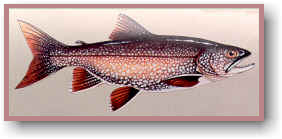
Lake Trout
Salvelinus namaycush
Status
Native to Labrador.
Habitat
Generally prefer deep waters. In Labrador, where lakes are often deep, may be found in water depths of 30 feet.
Range
All provinces in Canada. In this province, Lake Trout are only found in Labrador.
Food
Suckers, burbot, whitefish and pike, and are most vulnerable when they are young, causing young fish to move to deep water, out of reach from predators such as mature Lake Trout.
Appearance
Deeply forked tail; many small, often bean-shaped spots on its dark green to gray head, body and dorsal and caudal fins.
Breeding Biology
Spawn on rocky shoals and in river mouths at depths less then 40 feet of water in the fall. Sexual maturity occurs at about seven to eight years. Lake Trout will spawn every second or third year. Spawning events occur at night when water temperatures are between 8.9oC and 13.9oC. Spawning beds are first cleaned by brushing the bottom with both fins and body.
One or two males will spawn with each female. The number of eggs each female deposits depends on body size, but the range is between 400-1,200 eggs. Lake Trout are believed to return to the same spawning shoal from year to year. After spawning, Lake Trout will migrate long distances from the spawning beds, sometimes traveling up to 100 miles. In general egg incubation is between 15 to 21 weeks. No parental care is given the eggs after spawning.
